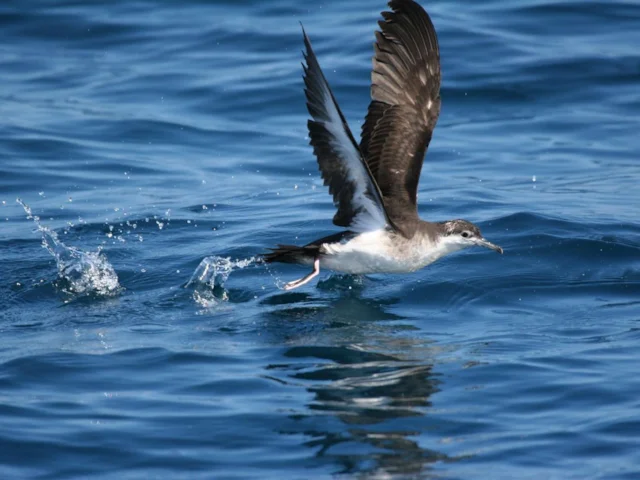Shearwater island now mouse-free
12125561-9c4c-4992-a079-e408ef474b5d

House Mice, which were depleting the numbers of Audubon’s Shearwater in the Bahamas, have now been eradicated on a key island, say BirdLife International.
Allen Cay in the Bahamas, an important breeding site for Audubon’s Shearwater and home of an endemic iguana, has been declared free of the invasive House Mouse which was threatening both native species.
“This announcement is a major milestone for the recovery of Allen Cay and we plan to replicate this success on other islands being damaged by invasive alien species,” said Eric Carey, Executive Director of BirdLife Partner the Bahamas National Trust (BNT).
The cay was 'de-moused' by a partnership including BNT, Island Conservation, Dr John Iverson of Earlham College, and Dr Will Mackin, Seabird Co-Chair of the Society for the Conservation and Study of Caribbean Birds.
Allen Cay is one of three cays in the Allen Cays Important Bird and Biodiversity Area in the northern Exuma Islands 60 km southeast of Nassau. The cays support the third largest breeding population of Audubon’s Shearwater in the Bahamas, as well as the endemic Allen Cay Rock Iguana, which is listed as Endangered by the IUCN. The inadvertent introduction of the non-native House Mouse led to an artificially high population of normally transient Barn Owls, which stayed to eat the mice, but ate shearwaters and young iguanas too. The shearwater mortality rate was twice as high on Allen Cay as nearby cays without mice.
Beginning in 2009, BirdLife International partners conducted extensive planning and field trials. The Bahamas Ministry of Environment authorised the project in April 2012, and the mice were removed in the following month. In the first week of June this year, the partners visited the Cay, confirmed the absence of mice and noted early signs of a recovering island ecosystem. Preliminary findings suggest a significant drop in shearwater mortality.
Mouse removal is part of a larger effort to restore the natural environment of Allen Cay. To minimise the risk of mouse reintroduction, BNT will develop a bio-security plan and work with recreational boaters and fishermen.
“Invasive species are the leading threat to the Caribbean’s rich biodiversity,” said David Wege, BirdLife’s Caribbean Programme Director. “By building local partnerships and training practitioners in the region in invasive species removal techniques, we are increasing capacity for island restoration to permanently protect the Caribbean’s native species.”
Allen Cay in the Bahamas, an important breeding site for Audubon’s Shearwater and home of an endemic iguana, has been declared free of the invasive House Mouse which was threatening both native species.
“This announcement is a major milestone for the recovery of Allen Cay and we plan to replicate this success on other islands being damaged by invasive alien species,” said Eric Carey, Executive Director of BirdLife Partner the Bahamas National Trust (BNT).
The cay was 'de-moused' by a partnership including BNT, Island Conservation, Dr John Iverson of Earlham College, and Dr Will Mackin, Seabird Co-Chair of the Society for the Conservation and Study of Caribbean Birds.
Allen Cay is one of three cays in the Allen Cays Important Bird and Biodiversity Area in the northern Exuma Islands 60 km southeast of Nassau. The cays support the third largest breeding population of Audubon’s Shearwater in the Bahamas, as well as the endemic Allen Cay Rock Iguana, which is listed as Endangered by the IUCN. The inadvertent introduction of the non-native House Mouse led to an artificially high population of normally transient Barn Owls, which stayed to eat the mice, but ate shearwaters and young iguanas too. The shearwater mortality rate was twice as high on Allen Cay as nearby cays without mice.
Beginning in 2009, BirdLife International partners conducted extensive planning and field trials. The Bahamas Ministry of Environment authorised the project in April 2012, and the mice were removed in the following month. In the first week of June this year, the partners visited the Cay, confirmed the absence of mice and noted early signs of a recovering island ecosystem. Preliminary findings suggest a significant drop in shearwater mortality.
Mouse removal is part of a larger effort to restore the natural environment of Allen Cay. To minimise the risk of mouse reintroduction, BNT will develop a bio-security plan and work with recreational boaters and fishermen.
“Invasive species are the leading threat to the Caribbean’s rich biodiversity,” said David Wege, BirdLife’s Caribbean Programme Director. “By building local partnerships and training practitioners in the region in invasive species removal techniques, we are increasing capacity for island restoration to permanently protect the Caribbean’s native species.”

